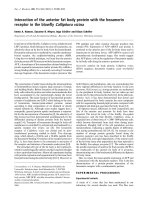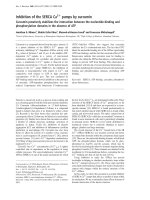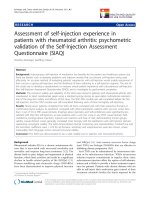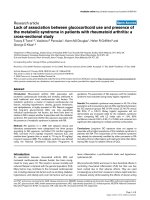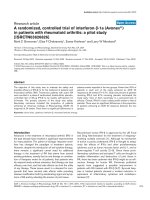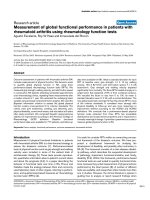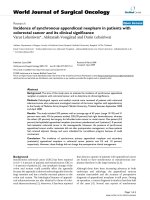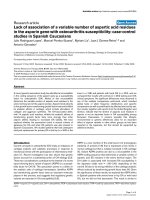Báo cáo y học: "Lack of association between glucocorticoid use and presence of the metabolic syndrome in patients with rheumatoid arthritis: a cross-sectional study" ppsx
Bạn đang xem bản rút gọn của tài liệu. Xem và tải ngay bản đầy đủ của tài liệu tại đây (174.7 KB, 8 trang )
Open Access
Available online />Page 1 of 8
(page number not for citation purposes)
Vol 10 No 6
Research article
Lack of association between glucocorticoid use and presence of
the metabolic syndrome in patients with rheumatoid arthritis: a
cross-sectional study
Tracey E Toms
1,2
, Vasileios F Panoulas
1
, Karen MJ Douglas
1
, Helen R Griffiths
3
and
George D Kitas
1,2
1
Department of Rheumatology, Dudley Group of Hospitals NHS Trust, Russells Hall Hospital, Dudley, West Midlands, DY1 2HQ, UK
2
Arthritis Research Campaign Epidemiology Unit, Manchester University, Oxford Road, Manchester, M13 9PL, UK
3
Life and Health Sciences, Aston University, Aston Triangle, Birmingham, West Midlands, B4 7ET, UK
Corresponding author: George D Kitas,
Received: 2 Oct 2008 Revisions requested: 31 Oct 2008 Revisions received: 23 Nov 2008 Accepted: 17 Dec 2008 Published: 17 Dec 2008
Arthritis Research & Therapy 2008, 10:R145 (doi:10.1186/ar2578)
This article is online at: />© 2008 Toms et al.; licensee BioMed Central Ltd.
This is an open access article distributed under the terms of the Creative Commons Attribution License ( />),
which permits unrestricted use, distribution, and reproduction in any medium, provided the original work is properly cited.
Abstract
Introduction Rheumatoid arthritis (RA) associates with
excessive cardiovascular morbidity and mortality, attributed to
both traditional and novel cardiovascular risk factors. The
metabolic syndrome, a cluster of classical cardiovascular risk
factors, including hypertension, obesity, glucose intolerance,
and dyslipidaemia, is highly prevalent in RA. Reports suggest
that long-term glucocorticoid (GC) use may exacerbate
individual cardiovascular risk factors, but there have been no
studies in RA to assess whether it associates with the metabolic
syndrome. We examined whether GC exposure associates with
the presence of metabolic syndrome in patients with RA.
Methods RA patients (n = 398) with detailed clinical and
laboratory assessments were categorised into three groups
according to GC exposure: no/limited (<3 months) exposure
(NE), low-dose (<7.5 mg/day) long-term exposure (LE), and
medium-dose (greater than or equal to 7.5 mg to 30 mg/day)
long-term exposure (ME). The metabolic syndrome was defined
using the National Cholesterol Education Programme III
guidelines. The association of GC exposure with the metabolic
syndrome was evaluated using binary logistic regression.
Results The metabolic syndrome was present in 40.1% of this
population and its prevalence did not differ significantly between
the GC exposure groups (NE 37.9% versus LE 40.7% versus
ME 50%, P = 0.241). Binary logistic regression did not
demonstrate any increased odds for the metabolic syndrome
when comparing ME with LE (odds ratio = 1.64, 95%
confidence interval 0.92 to 2.92, P = 0.094) and remained non
significant after adjusting for multiple potential confounders.
Conclusions Long-term GC exposure does not appear to
associate with a higher prevalence of the metabolic syndrome in
patients with RA. The components of the metabolic syndrome
may already be extensively modified by other processes in RA
(including chronic inflammation and treatments other than GCs),
leaving little scope for additive effects of GCs.
Introduction
An association between rheumatoid arthritis (RA) and
increased cardiovascular disease burden has been recog-
nised for many years [1]. This results in excess mortality and
reduced lifespan compared with the general population [2,3].
Many factors may contribute to the increased cardiovascular
risk, including classical risk factors such as smoking, diabetes,
hypertension, and obesity and novel risk factors such as sys-
temic inflammation, a prothrombotic state, and hyperhomo-
cystinaemia [4].
Glucocorticoids (GCs) are known to have beneficial effects in
controlling rheumatoid inflammation [5,6] but their use has
been curbed due to their adverse effects. They are used
increasingly as a short-term measure to induce rapid reduction
in disease activity whilst awaiting the effects of slower acting
anti-TNF: anti-tumour necrosis factor; DAS: disease activity score; DMARD: disease-modifying anti-rheumatic drug; ESR: erythrocyte sedimentation
rate; GC: glucocorticoid; HAQ: health assessment questionnaire; HDL: high-density lipoprotein; LE: limited exposure; NCEP III: National Cholesterol
Education Programme III; NE: no exposure; OR: odds ratio; RA: rheumatoid arthritis; TG: triglyceride.
Arthritis Research & Therapy Vol 10 No 6 Toms et al.
Page 2 of 8
(page number not for citation purposes)
disease-modifying anti-rheumatic drugs (DMARDs) [7]. Long-
term use of GCs is controversial due to an undesirable side
effect profile that includes dyslipidaemia [8], hyperglycaemia
[9], insulin resistance [10], hypertension [11,12], and central
obesity [11]: these may collectively contribute to the develop-
ment of the metabolic syndrome [13,14] and atherosclerosis
[15,16].
The metabolic syndrome, first described by Reaven in 1988
[17], is a cluster of classical cardiovascular risk factors (obes-
ity, glucose intolerance, dyslipidaemia, and hypertension)
thought to associate with cardiovascular risk beyond the sum
of its individual components [18], although this has recently
been questioned [19]. It is estimated that the metabolic syn-
drome affects 20% to 30% of the adult population in devel-
oped countries [20-22] but its prevalence varies according to
the definition used as well as environmental and genetic differ-
ences between populations [22]. As a consequence of physi-
cal inactivity and poor diet, rates of obesity and diabetes are
increasing worldwide [23,24], with an expected exponential
rise in the percentage of the population affected by the meta-
bolic syndrome [23]. The pathogenesis underlying the cluster-
ing of cardiovascular risk factors remains unclear: genetic
predisposition, obesity, and inflammation have been sug-
gested to be involved [25,26]. A recent study has shown that
patients with RA have a higher prevalence of metabolic syn-
drome than controls [27], although another study has demon-
strated an equally high prevalence between Mediterranean RA
patients and local general population controls [28]. In the
present cross-sectional study, we addressed the hypothesis
that RA patients receiving long-term GC will have an
increased prevalence of each of the individual components of
the metabolic syndrome (dyslipidaemia, hypertension, hyperg-
lycaemia, and central obesity) as well as the metabolic syn-
drome itself.
Materials and methods
RA patients (n = 398) fulfilling the revised American College
of Rheumatology criteria [29] were recruited from routine out-
patient clinics at the Department of Rheumatology, Dudley
Group of Hospitals NHS Trust (Dudley, West Midlands, UK).
Characteristics of the study population are shown in Table 1.
Local ethics committee approval was granted for the study
and all participants provided informed consent.
All patients underwent the same baseline evaluation prospec-
tively. The following details were recorded: basic demograph-
ics (that is, age, gender, height, weight, and waist
circumference), a full medical history (including specific
details regarding RA and cardiovascular disease), and current
disease activity and physical function, using the 28-joint dis-
ease activity score (DAS-28) [30] and health assessment
questionnaire (HAQ) [31], respectively. All current medica-
tions, including anti-rheumatic drugs, analgesics, and cardio-
vascular drugs such as statins or anti-hypertensives, were
documented. Information regarding GC (oral prednisolone)
dose and duration of exposure was recorded and categorised
into none or low-dose (<7.5 mg of prednisolone daily), limited
duration (<3 months) GC exposure (no exposure, NE), low-
dose long-term (>6 months) (low exposure, LE), or medium-
dose (prednisolone at least 7.5 to 30 mg daily for more than 6
months) long-term (medium exposure). There were no patients
exposed to high-dose long-term GC. Baseline blood samples,
including fasting lipid profiles (total cholesterol, triglycerides
(TGs), and high-density lipoproteins (HDLs)), erythrocyte sed-
imentation rate (ESR), C-reactive protein, fasting glucose,
insulin, and rheumatoid factor, were taken. All blood tests were
analysed by a single laboratory. The metabolic syndrome was
classified by National Cholesterol Education Programme III
(NCEP III) criteria [32]: fasting plasma glucose of at least 6.1
mmol/L or on drug treatment for elevated blood glucose,
systolic blood pressure of at least 130/85 mm Hg or on drug
treatment for elevated blood pressure, TG at least 1.7 mmol/L
or drug treatment for elevated TG, HDL in males of less than
1.0 mmol/L and in females of less than 1.3 mmol/L or on drug
treatment for a low HDL, and waist circumferences in males of
greater than 102 cm and in females of greater than 88 cm,
with the metabolic syndrome defined as the presence of at
least three of these criteria [32].
Analysis of the data was carried out using SPSS 14.0 (SPSS
Inc., Chicago, IL, USA). The Kolmogorov-Smirnov test was
used to evaluate the distribution of each parameter. Values
were expressed as mean ± standard deviation, median (25th–
75th percentile), or number (percentage), as appropriate.
Comparisons were performed by analysis of variance, Kruskal-
Wallis, and chi-square test for normally distributed, non-nor-
mally distributed, and categorical variables, respectively. To
evaluate the independence of the association between GC
exposure and the metabolic syndrome, binary logistic regres-
sion analysis was used.
Results
Descriptive characteristics of the population studied
Median (interquartile range) age in the total cohort was 63.08
(55.46 to 69.62) years, disease duration was 10 (4 to 18)
years, and 292 (73%) of the patients were female. Three hun-
dred forty patients (87.4%) were receiving DMARDs (two
thirds as monotherapy and the remaining as combination ther-
apy), of whom 225 (56.3%) were taking methotrexate, 118
(29.5%) sulphasalazine, 80 (20%) hydroxycholoroquine, 16
(4%) leflunomide, and 46 (11.5%) anti-tumour necrosis factor
(anti-TNF) biologics; 111 patients (27.8%) were on nonsteroi-
dal anti-inflammatory drugs or cyclooxygenase II inhibitors.
One third of the cohort, 117 patients (29.4%), were taking
GCs, with similar numbers in the LE and ME groups (58 ver-
sus 59 patients, respectively). Other drugs included statins in
83 (20.8%) and antihypertensives in 177 (44.5%) patients.
Further baseline characteristics of the study population are
described in detail in previous papers by our group [12,33].
Available online />Page 3 of 8
(page number not for citation purposes)
Table 1
Demographics and clinical and laboratory characteristics of the glucocorticoid exposure groups
NE (n = 281) LE (n = 58) ME (n = 59) P value
General demographics
Age, years 62 (53.03–68.56) 66.01 (59–71.47) 66.6 (60.7–71.6) 0.002
Gender female, number (percentage) 214 (76.2) 41 (70.7) 36 (61) 0.053
RA characteristics
RF-positive, number (percentage) 210 (76.4) 42 (73.7) 43 (75.4) 0.909
Anti-CCP-positive, number (percentage) 181 (67.5) 36 (63.2) 41 (73.2) 0.517
Disease duration, years 7 (3–15) 16 (10–25.5) 18 (10–39) <0.001
Disease activity
CRP, mg/L 8 (5–18) 8 (5–17) 9 (5–28) 0.421
ESR, mm/h 20 (10–38) 15.5 (6.75–29.25) 26 (12–45) 0.031
DAS-28 4.15 ± 1.38 4.09 ± 1.37 4.59 ± 1.47 0.080
Disease severity
HAQ 1.38 (0.5–2) 1.63 (0.72–2.16) 2.13 (1.63–2.5) <0.001
Extra-articular disease, number (percentage) 180 (64.1) 42 (72.4) 45 (76.3) 0.124
Joint replacement surgery, number (percentage) 65 (23.1) 21 (36.2) 29 (49.2) <0.001
Medications
Methotrexate, number (percentage) 161 (57.3) 35 (60.3) 28 (47.5) 0.305
Sulphasalazine, number (percentage) 96 (34.2) 11 (19) 11 (18.6) 0.009
Hydroxychloroquine, number (percentage) 57 (20.3) 13 (22.4) 10 (16.9) 0.754
Leflunomide, number (percentage) 11 (3.9) 1 (1.7) 4 (6.8) 0.374
Anti-TNF, number (percentage) 29 (10.3) 9 (15.5) 7 (11.9) 0.518
NSAIDS/COX II, number (percentage) 82 (29.2) 15 (25.9) 13 (22) 0.508
Risk factors for the MetS
Waist, cm 97.12 ± 12.39 97.35 ± 14.3 100.9 ± 15.19 0.172
Trigylcerides, mmol/L 1.2 (0.9–1.6) 1.2 (0.9–1.63) 1.4 (1.1–1.8) 0.010
Systolic blood pressure, mm Hg 140 (126.25–150) 142 (125.75–159) 145 (135–160) 0.022
Diastolic blood pressure, mm Hg 78.66 ± 10.85 79.97 ± 10.82 79.06 ± 13.06 0.716
HDL, mmol/L 1.5 (1.2–1.8) 1.7 (1.38–2.03) 1.7 (1.4–2) 0.011
LDL, mmol/L 5.2 ± 1.07 5.31 ± 1.27 5.25 ± 1.54 0.798
Criteria for MetS
Waist M, number (percentage) 163 (65.2) 32 (65.3) 36 (69.2) 0.853
Triglycerides M, number (percentage) 96 (34.2) 24 (41.4) 31 (52.5) 0.026
Hypertension M, number (percentage) 220 (78.3) 45 (77.6) 55 (93.2) 0.027
HDL M, number (percentage) 94 (33.5) 20 (34.5) 24 (40.7) 0.570
Fasting plasma glucose M, number (percentage) 38 (13.5) 9 (15.8) 14 (24.1) 0.125
Patients fulfilling criteria of MetS
NCEP, number (percentage) 105 (37.9) 22 (40.7) 28 (50.0) 0.241
Arthritis Research & Therapy Vol 10 No 6 Toms et al.
Page 4 of 8
(page number not for citation purposes)
Univariate analysis
Patients in the LE and ME groups were older (P = 0.002) and
had longer disease duration (P < 0.001) and higher ESR (P =
0.031) and HAQ (P < 0.001) and more frequent joint replace-
ment surgery (P < 0.001) than those in the NE group (Table
1). There were no significant differences between LE and ME.
Of the risk factors for the metabolic syndrome, TG, systolic
blood pressure, and HDL were all higher in patients receiving
long-term GCs (LE or ME). TGs were significantly higher in the
ME group (P = 0.010) compared with NE, but no significant
difference was noted between LE and NE. Systolic blood
pressure increased as GC exposure increased (NE 140
(126.25 to 150) mm Hg versus LE 142 (125.75 to 159) mm
Hg versus ME 145 (135 to 160) mm Hg, P = 0.022). Interest-
ingly, HDL levels were higher in the LE and ME groups (P =
0.011).
The individual components that comprise the metabolic syn-
drome were analysed to assess the proportion of patients in
each of the GC exposure groups fulfilling the NCEP III-defined
cut off levels. TG levels adequate for contributing as a compo-
nent of the metabolic syndrome were observed in a signifi-
cantly higher proportion of patients in the LE and ME groups
compared with NE (P = 0.026). The NCEP III cut off for hyper-
tension was present in a significantly higher proportion of
patients in the ME group (P = 0.027) but not in the LE group.
The other individual components that contribute to the defini-
tion of the metabolic syndrome (waist circumference, HDL,
and fasting plasma glucose) were observed in similar propor-
tions of patients within the NE, LE, and ME groups.
On combining the individual components to fulfil the NCEP III
criteria for the metabolic syndrome (presence of at least three
of the components), there was no evidence of a significant
association between the degree of GC exposure and the pres-
ence of the metabolic syndrome (NE 105 (37.9%) versus LE
22 (40.7%) versus ME 28 (50%), P = 0.241). Factors identi-
fied to be significantly associated with both the metabolic syn-
drome and GC exposure, thus acting as potential
confounders, included age (P = 0.001 and P = 0.002, respec-
tively), RA disease duration (P = 0.008 and P < 0.001), ESR
(P = 0.006 and P = 0.031), and HAQ (P = 0.036 and P <
0.001).
Multivariate analysis
The association between GC exposure and the frequency of
the metabolic syndrome was assessed using a logistic regres-
sion model (Table 2). The analysis did not demonstrate a sta-
tistically significant association between LE (odds ratio (OR)
= 1.13 (0.62 to 2.04), P = 0.695) or ME (OR = 1.64 (0.92 to
2.92), P = 0.094) and the metabolic syndrome in either the
crude model or following adjustment for all of the potential
confounders mentioned above (age, ESR, disease duration,
and HAQ; for completeness, gender was also added to the
model): LE OR = 1.15 (0.61 to 2.19) (P = 0.670) and ME OR
= 1.4 (0.72 to 2.58) (P = 0.340). For reasons of colinearity,
ESR and DAS could not be included in the same model. How-
Results expressed as number (percentage), median (25th–75th percentile), or mean ± standard deviation, as appropriate. Anti-CCP, anti-cyclic
citrullinated peptide; anti-TNF, anti-tumour necrosis factor therapy; CRP, C-reactive protein; HAQ, health assessment questionnaire; DAS-28, 28-
joint disease activity score; ESR, erythrocyte sedimentation rate; Triglycerides M, triglycerides of at least 1.7 mmol/L or on drug treatment for
elevated triglycerides; Waist M, waist circumference of greater than 102 cm in males and greater than 88 cm in females. Fasting plasma glucose
M, fasting plasma glucose of at least 6.1 mmol/L or on drug treatment for elevated blood glucose; HDL, high-density lipoprotein; HDL M, high-
density lipoprotein level of less than 1.0 mmol/L in males or less than 1.3 mmol/L in females or on drug treatment for low HDL; Hypertension M,
systolic blood pressure of at least 130/85 mm Hg or on antihypertensive medication; LDL, low-density lipoprotein; LE, low-dose/long-term
exposure; ME, moderate-dose/long-term exposure; MetS, metabolic syndrome; NCEP, National Cholesterol Education Programme; NE, none/
limited exposure; NSAIDs/COX II, nonsteroidal anti-inflammatory drugs/cyclooxygenase II inhibitors; RA, rheumatoid arthritis; RF, rheumatoid
factor;
Table 1 (Continued)
Demographics and clinical and laboratory characteristics of the glucocorticoid exposure groups
Table 2
Odds ratios for the metabolic syndrome (NCEP III) in comparison with the amount of steroid exposure
LD/LTE MD/LTE
OR (95% CI) P value OR (95% CI) P value
Crude 1.13 (0.62–2.04) 0.695 1.64 (0.92–2.92) 0.094
Model a 0.998 (0.54–1.83) 0.994 1.37 (0.75–2.48) 0.304
Model b 1.15 (0.61–2.19) 0.670 1.4 (0.72–2.58) 0.340
Crude = uncorrected data. Model a = crude data plus adjustment for age and gender. Model b = model a plus adjustment for markers of disease
activity/severity (disease duration, erythrocyte sedimentation rate levels, and health assessment questionnaire). CI, confidence interval; LD/LTE,
low-dose/long-term exposure; MD/LTE, moderate-dose/long-term exposure; NCEP III, National Cholesterol Education Programme III; OR, odds
ratio.
Available online />Page 5 of 8
(page number not for citation purposes)
ever, to ensure that disease activity per se (rather than ESR
alone) did not alter the results, the model was repeated includ-
ing DAS instead of ESR. Despite this, no significant associa-
tion was found between LE (OR = 1.189, P = 0.601) or ME
(OR = 1.453, P = 0.262) and the metabolic syndrome.
Discussion
This cross-sectional observational study has demonstrated
that long-term exposure to GCs, particularly at medium doses,
is associated with increased prevalence of two of the compo-
nents of the metabolic syndrome (high TG and hypertension),
but not any of the other components (low HDL, obesity, and
glucose intolerance) or the presence of the metabolic syn-
drome itself. We have presented data having used the NECP
III criteria for metabolic syndrome as they are the most up-to-
date and widely used, allowing comparison of our results with
those of other studies in RA and other conditions. However,
for the purpose of completeness, we have also analysed the
data on the basis of other metabolic syndrome classification
criteria, including those of the World Health Organisation [34],
the International Diabetes Federation [35], and the European
Group for the Study of Insulin Resistance [36], in order to
ensure that the definition used would not affect the outcome
of this study. The lack of any association between GC expo-
sure and the presence of the metabolic syndrome in this RA
cohort was present irrespective of the metabolic syndrome cri-
teria used (data not shown).
Although no statistically significant association between GC
exposure and the metabolic syndrome was found, the multivar-
iate analysis did demonstrate a trend in the OR as steroid
exposure increased (LE 1.13 (0.62 to 2.04) versus ME 1.64
(0.92 to 2.92)). Thus, a possible limitation of the present study
may be that, despite the fact that it is by far the largest to date
to assess metabolic syndrome in RA, its power may not have
been sufficient to detect such an association, although the
clinical significance of such a weak association would then
come into question. The most important limitation of this study,
however, is its cross-sectional design, which does not allow
definitive interpretation of the causality and directionality of the
associations found. Notwithstanding these limitations, this
study has addressed an original question that has not been
addressed elsewhere in the literature in a large, very well-char-
acterised RA population, with prospective data collection,
thus allowing adjustment for many potential confounders and
minimising selection and recall bias or missing values, which
are all common problems in retrospective studies.
The absence of a relationship between long-term GC use and
the presence of the metabolic syndrome may be explained by
physical and metabolic changes occurring as part of the dis-
ease process or as an indirect consequence of treatments
other than steroids [37-39]. It is possible that the beneficial
effects produced by suppressing the impact of inflammation
on the metabolic syndrome may outweigh the harmful effects
of GCs. For example, in RA, many components of the lipid pro-
file are suppressed by the ongoing inflammatory burden,
including HDL [40]. However, suppression of the inflammatory
load via drug use (for example, DMARDs) produces a signifi-
cant increase in lipid levels, particularly HDL [41]. Conversely,
it may be that patients with RA have significantly modified their
risk factors for the metabolic syndrome as a consequence of
inflammation and that the addition of GC use cannot worsen
these further.
Central obesity is associated with increased cardiovascular
risk and is one of the components of the metabolic syndrome.
GC use has been shown to redistribute body fat and result in
central obesity with relative sparing of the extremities [42].
Long-term GC use can also be complicated by the develop-
ment of a steroid-induced myopathy [37-39,43], which may
further exacerbate the imbalance between fat mass and mus-
cle bulk. Although steroid myopathy primarily manifests with
proximal muscle weakness in the absence of muscle atrophy
[44], muscle wasting may occur as a consequence of a reduc-
tion in functional capacity. The systemic inflammation associ-
ated with RA causes a hypercatabolic state, which, together
with a sedentary lifestyle, results in a loss of muscle bulk and
an increased tendency to gain fat in the presence of stable or
even slightly decreased weight, often referred to as rheuma-
toid cachexia [45]. It has been reported that almost two thirds
of patients with RA have features of rheumatoid cachexia [46],
and a recent study has demonstrated the need for redefining
the body mass index in RA to take into account these changes
[33]. It is therefore possible that, in RA patients, alterations in
body fat/muscle may have already occurred as part of the dis-
ease process and thus any additional changes that are
induced by long-term GC exposure may be insignificant. Alter-
natively, better control of inflammation due to steroid usage
may counterbalance some of the body composition abnormal-
ities that would have otherwise occurred. The latter possibility
would be supported by our findings in RA patients treated with
anti-TNF biologics [47].
A relationship between RA and abnormalities in the lipid profile
has been observed for several decades [48], with the key con-
tributing factor thought to be inflammation [49]. The typical
pattern of dyslipidaemia seen in active RA is a reduction in
total cholesterol, low-density lipoprotein, and HDL [40]. Data
regarding TG levels in RA are conflicting, with some studies
reporting an increase [50] and others a decrease [51]. The
metabolic syndrome definition takes in to account only two
components of the lipid profile, TG and HDL. GC use, inde-
pendent of dose, has been shown to increase HDL levels [52-
54]. Endogenous GC hormones regulate HDL plasma con-
centrations by increasing synthesis and secretion by the liver
[55]. Consequently, high doses of exogenous GCs such as
those being received by RA patients are likely to accelerate
this pathway. Therefore, in RA, HDL levels previously sup-
pressed by disease activity will rise, producing a less athero-
Arthritis Research & Therapy Vol 10 No 6 Toms et al.
Page 6 of 8
(page number not for citation purposes)
genic profile. This was reflected in our study, in which an
increase in HDL levels was seen in patients receiving long-
term GCs (P = 0.011). The observed rise in HDL levels may
also be explained by the indirect effects of GCs. Patients
requiring GCs as part of their disease management are likely
to have aggressive disease, which contributes to a reduction
in mobility as a result of joint stiffness and damage. Therefore,
GC use in this subset of patients may result in suppression of
disease activity and allow patients to lead a more active life-
style with a further beneficial effect on HDL levels [56].
Elevation of TG levels in patients receiving GCs on a long-term
basis has also been demonstrated [57,58]. However, many of
the studies have been limited due to the lack of control for
other potential lipid-influencing factors such as metabolic,
nutritional, or comorbid conditions. Although the proportion of
patients fulfilling the NCEP III-specified cut off levels for TGs
was significantly higher in the group receiving long-term GCs
in this study (P = 0.026), this alone was not sufficient to
impact significantly on the overall prevalence of the metabolic
syndrome, possibly being counterbalanced by increases in
HDL, producing an overall less atherogenic lipid profile.
Shortly after the discovery of GC by Hench and colleagues
[59] in 1948, it became apparent that patients were frequently
developing adverse effects, including hypertension and diabe-
tes [60]. Despite this, there is limited evidence to support
these initial observations. In the general population, studies
attempting to assess the association between GC use and
hypertension have been hampered by poor study design [61],
thus resulting in a distinct lack of direct evidence to support
this relationship. In RA, this association has been studied in
more detail, with two recent studies demonstrating an
increase in blood pressure in patients treated with long-term
medium-dose ( 7.5 mg) GC [12,62]. One of these studies, a
large cross-sectional study, confirmed an association inde-
pendent of other risk factors for hypertension and RA disease
activity or severity [12]. Although it appears that there is a link
between GC exposure and hypertension in RA, it has also
been speculated that RA itself may predispose patients to an
increased prevalence of hypertension [63]. The data pro-
duced in the present study show a significant increase in the
numbers of patients fulfilling the NCEP III-specified cut off lev-
els for hypertension (= 130/85 mm Hg or taking anti-hyperten-
sives) in those receiving long-term GC. It may be that, despite
hypertension being prevalent in RA, there is still scope for fur-
ther modification through the actions of GCs. Irrespective of
this, it appears again that the increased frequency of patients
satisfying both the hypertensive and hypertrigylceridaemic
components of the metabolic syndrome in the steroid-treated
group is not sufficient to also increase the frequency of those
qualifying for a diagnosis of the metabolic syndrome.
GC-induced hyperglycaemia is a well-recognised complica-
tion of long-term GC use [64]. It is known that patients with
active RA have impaired glucose handling and that glucose
metabolism may be affected directly or indirectly by inflamma-
tory mediators [65]. Several studies have demonstrated an
association between GC use and decreased insulin sensitivity
[10,66,67]. However, there is smaller bank of conflicting data
demonstrating that GC use in RA paradoxically restores glu-
cose handling to normal whilst also inducing hyperinsulinism
[68]. In the present RA population, it is possible that GC use
restored glucose handling to normal via anti-inflammatory
mechanisms, hence explaining why this component was not
significant in the univariate analysis and had no impact on the
frequency of the metabolic syndrome.
Conclusion
In summary, this study suggests that the presence of the met-
abolic syndrome in RA appears to be independent of the use
of GCs. It is possible that the disease process itself is the key
contributor. This would suggest that effective management of
metabolic syndrome in RA is likely to require a two-pronged
approach: identification and management of individual classi-
cal risk factors, particularly hypertension and hypertriglyceri-
daemia, as well as aggressive control of inflammatory disease
activity with available means, including judicious usage of
GCs.
Competing interests
The authors declare that they have no competing interests.
Authors' contributions
TET participated in the conception and design of the project
and in the analysis and interpretation of data and contributed
substantially to the drafting of the manuscript. VFP partici-
pated in the acquisition, analysis, and interpretation of data.
KMJD contributed to the acquisition of data. HRG contributed
to the revision of the draft of the manuscript. GDK contributed
substantially to the conception and design of the project and
to the revision of the draft of the manuscript. All authors read
and approved the final manuscript.
Acknowledgements
TET was funded by a research fellowship from the Dudley Group of Hos-
pitals NHS Trust; the Department of Rheumatology is in receipt of infra-
structure support from the Arthritis Research Campaign (grant number
17682). VFP is supported by a PhD scholarship from the Empirikion
Institute (Athens, Greece).
References
1. Cobb S, Anderson D, Bauer W: Length of life and cause of
death in rheumatoid arthritis. N Engl J Med 1953,
249:553-556.
2. Kitas GD, Erb N: Tackling ischaemic heart disease in rheuma-
toid arthritis. Rheumatology (Oxford) 2003, 42:607-613.
3. Van Doornum S, McColl G, Wicks IP: Accelerated atherosclero-
sis: an extraarticular feature of rheumatoid arthritis? Arthritis
Rheum 2002, 46:862-873.
4. Stevens RJ, Douglas KM, Saeatzis AN, Kitas GD: Inflammation
and atherosclerosis in rheumatoid arthritis. Expert Rev Mol
Med 2005, 7:1-24.
Available online />Page 7 of 8
(page number not for citation purposes)
5. EMPIRE Rheumatism Council: multi-centre controlled trial
comparing cortisone acetate and acetyl salicylic acid in the
long-term treatment of rheumatoid arthritis; results of three
years' treatment. Ann Rheum Dis 1957, 16:277-289.
6. Kirwan JR: The effect of glucocorticoids on joint destruction in
rheumatoid arthritis. The Arthritis and Rheumatism Council
Low-Dose Glucocorticoid Study Group. N Engl J Med 1995,
333:142-146.
7. Bijlsma JW, Van Everdingen AA, Huisman M, De Nijs RN, Jacobs
JW: Glucocorticoids in rheumatoid arthritis: effects on ero-
sions and bone. Ann N Y Acad Sci 2002, 966:82-90.
8. el Shaboury AH, Hayes TM: Hyperlipidaemia in asthmatic
patients receiving long-term steroid therapy. Br Med J 1973,
2:85-86.
9. Panthakalam S, Bhatnagar D, Klimiuk P: The prevalence and
management of hyperglycaemia in patients with rheumatoid
arthritis on corticosteroid therapy. Scott Med J 2004,
49:139-141.
10. Sarzi-Puttini P, Atzeni F, Schölmerich J, Cutolo M, Straub RH: Anti-
TNF antibody treatment improves glucocorticoid induced
insulin-like growth factor 1(IGF1) resistence without influenc-
ing myoglobin and IGF1 binding proteins 1 and 3. Ann Rhuem
Dis 2006, 65:301-305.
11. Fraser R, Ingram MC, Anderson NH, Morrison C, Davies E, Connell
JM: Cortisol effects on body mass, blood pressure, and cho-
lesterol in the general population. Hypertension 1999,
33:1364-1368.
12. Panoulas VF, Douglas KM, Stavropoulos-Kalinoglou A, Metsios
GS, Nightingale P, Kita MD, Elisaf MS, Kitas GD: Long-term
exposure to medium-dose glucocorticoid therapy associates
with hypertension in patients with rheumatoid arthritis. Rheu-
matology (Oxford) 2008, 47:72-75.
13. Pasquali R, Vicennati V: Steroids and the metabolic syndrome.
J Steroid Biochem Mol Biol 2008, 109:258-265.
14. Rike AH, Mogilishetty G, Alloway RR, Succop P, Roy-Chaudhury
P, Cardi M, Kaiser TE, Thomas M, Woodle ES: Cardiovascular
risk, cardiovascular events, and metabolic syndrome in renal
transplantation: comparison of early steroid withdrawal and
chronic steroids. Clin Transplant 2008, 22:229-235.
15. Varas-Lorenzo C, Rodriguez LA, Maguire A, Castellsague J, Perez-
Gutthann S: Use of oral corticosteroids and the risk of acute
myocardial infarction. Atherosclerosis 2007, 192:376-383.
16. Dessein PH, Tobias M, Veller MG: Metabolic syndrome and sub-
clinical atherosclerosis in rheumatoid arthritis. J Rheumatol
2006, 33:2425-2432.
17. Reaven GM: Banting lecture 1988. Role of insulin resistance in
human disease. Diabetes 1988, 37:1595-1607.
18. Reilly MP, Rader DJ: The metabolic syndrome: more than the
sum of its parts? Circulation 2003, 108:1546-1551.
19. Sattar N, McConnachie A, Shaper AG, Blauw GJ, Buckley BM, de
Craen AJ, Ford I, Forouhi NG, Freeman DJ, Jukema JW, Lennon L,
Macfarlane PW, Murphy MB, Packard CJ, Stott DJ, Westendorp
RG, Whincup PH, Shepherd J, Wannamethee SG: Can metabolic
syndrome usefully predict cardiovascular disease and diabe-
tes? Outcome data from two prospective studies. Lancet
2008, 371:1927-1935.
20. Ford ES, Giles WH, Dietz WH: Prevalence of the metabolic syn-
drome among US adults: findings from the third National
Health and Nutrition Examination Survey. JAMA 2002,
287:356-359.
21. Ilanne-Parikka P, Eriksson JG, Lindström J, Hämäläinen H,
Keinänen-Kiukaanniemi S, Laakso M, Louheranta A, Mannelin M,
Rastas M, Salminen V, Aunola S, Sundvall J, Valle T, Lahtela J,
Uusitupa M, Tuomilehto J, Finnish Diabetes Prevention Study
Group: Prevalence of the metabolic syndrome and its compo-
nents: findings from a Finnish general population sample and
the Diabetes Prevention Study cohort. Diabetes Care 2004,
27:2135-2140.
22. Meigs JB, Wilson PW, Nathan DM, D'Agostino RB Sr, Williams K,
Haffner SM: Prevalence and characteristics of the metabolic
syndrome in the San Antonio Heart and Framingham Off-
spring Studies. Diabetes 2003, 52:2160-2167.
23. Prentice AM: The emerging epidemic of obesity in developing
countries. Int J Epidemiol 2006, 35:93-99.
24. Wild S, Roglic G, Green A, Sicree R, King H: Global prevalence
of diabetes: estimates for the year 2000 and projections for
2030. Diabetes Care 2004, 27:1047-1053.
25. Kakafika AI, Liberopoulos EN, Karagiannis A, Athyros VG, Mikhai-
lidis DP:
Dyslipidaemia, hypercoagulability and the metabolic
syndrome. Curr Vasc Pharmacol 2006, 4:175-183.
26. Tracy RP: Inflammation, the metabolic syndrome and cardio-
vascular risk. Int J Clin Pract Suppl 2003, 134:10-17.
27. Chung CP, Oeser A, Solus JF, Avalos I, Gebretsadik T, Shintani A,
Raggi P, Sokka T, Pincus T, Stein CM: Prevalence of the meta-
bolic syndrome is increased in rheumatoid arthritis and is
associated with coronary atherosclerosis. Atherosclerosis
2007, 196:756-763.
28. Karvounaris SA, Sidiropoulos PI, Papadakis JA, Spanakis EK, Bert-
sias GK, Kritikos HD, Ganotakis ES, Boumpas DT: Metabolic syn-
drome is common among middle-to-older aged
Mediterranean patients with rheumatoid arthritis and corre-
lates with disease activity: a retrospective, cross-sectional,
controlled, study. Ann Rheum Dis 2007, 66:28-33.
29. Arnett FC, Edworthy SM, Bloch DA, McShane DJ, Fries JF, Cooper
NS, Healey LA, Kaplan SR, Liang MH, Luthra HS, Medsger TA Jr,
Mitchell DM, Neustadt DH, Pinals RS, Schaller JG, Sharp JT,
Wilder RL, Hunder GG: The American Rheumatism Association
1987 revised criteria for the classification of rheumatoid arthri-
tis. Arthritis Rheum 1988, 31:315-324.
30. Prevoo ML, 't Hof MA, Kuper HH, van Leeuwen MA, Putte LB van
de, van Riel PL: Modified disease activity scores that include
twenty-eight-joint counts. Development and validation in a
prospective longitudinal study of patients with rheumatoid
arthritis. Arthritis Rheum 1995, 38:44-48.
31. Kirwan JR, Reeback JS: Stanford Health Assessment Question-
naire modified to assess disability in British patients with
rheumatoid arthritis. Br J Rheumatol 1986, 25:206-209.
32. Executive Summary of The Third Report of The National Cho-
lesterol Education Program (NCEP) Expert Panel on Detection,
Evaluation, And Treatment of High Blood Cholesterol In Adults
(Adult Treatment Panel III). JAMA 2001, 285:2486-2497.
33. Stavropoulos-Kalinoglou A, Metsios GS, Koutedakis Y, Nevill AM,
Douglas KM, Jamurtas A, Veldhuijzen van Zanten JJ, Labib M, Kitas
GD: Redefining overweight and obesity in rheumatoid arthritis
patients. Ann Rheum Dis 2007, 66:1316-1321.
34. Alberti KG, Zimmet PZ: Definition, diagnosis and classification
of diabetes mellitus and its complications. Part 1: diagnosis
and classification of diabetes mellitus provisional report of a
WHO consultation. Diabet Med 1998,
15:539-553.
35. Alberti KG, Zimmet P, Shaw J: The metabolic syndrome – a new
worldwide definition. Lancet 2005, 366:1059-1062.
36. Balkau B, Charles MA: Comment on the provisional report from
the WHO consultation. Diabetic medicine 1999, 16:442-443.
37. Myers J: Cardiology patient pages. Exercise and cardiovascular
health. Circulation 2003, 107:e2-e5.
38. Rozman B, Praprotnik S, Logar D, Tomsic M, Hojnik M, Kos-Golja
M, Accetto R, Dolenc P: Leflunomide and hypertension. Ann
Rheum Dis 2002, 61:567-569.
39. Turesson C, Matteson EL: Is atherosclerosis in rheumatoid
arthritis related to disease severity and extraarticular manifes-
tations? Comment on the article by Chung et al. Arthritis
Rheum 2006, 54:1353-1354.
40. Situnayake RD, Kitas G: Dyslipidemia and rheumatoid arthritis.
Ann Rheum Dis 1997, 56:341-342.
41. Georgiadis AN, Papavasiliou EC, Lourida ES, Alamanos Y, Kostara
C, Tselepis AD, Drosos AA: Atherogenic lipid profile is a feature
characteristic of patients with early rheumatoid arthritis: effect
of early treatment – a prospective, controlled study. Arthritis
Res Ther 2006, 8:R82.
42. Wajchenberg BL, Bosco A, Marone MM, Levin S, Rocha M, Lerario
AC, Nery M, Goldman J, Liberman B: Estimation of body fat and
lean tissue distribution by dual energy X-ray absorptiometry
and abdominal body fat evaluation by computed tomography
in Cushing's disease. J Clin Endocrinol Metab 1995,
80:2791-2794.
43. Askari A, Vignos PJ, Morkavitz RW: Steroid myopathy in connec-
tive tissue disease. Am J Med 1976, 61:485-492.
44. Afifi AK, Bergman RA, Harvey JC: Steroid myopathy. Clinical,
histologic and cytologic observations. Johns Hopkins Med J
1968, 123:158-173.
45. Rall LC, Roubenoff R: Rheumatoid cachexia: metabolic abnor-
malities, mechanisms and interventions. Rheumatology
(Oxford) 2004,
43:1219-1223.
Arthritis Research & Therapy Vol 10 No 6 Toms et al.
Page 8 of 8
(page number not for citation purposes)
46. Roubenoff R, Roubenoff RA, Cannon JG, Kehayias JJ, Zhuang H,
Dawson-Hughes B, Dinarello CA, Rosenberg IH: Rheumatoid
cachexia: cytokine-driven hypermetabolism accompanying
reduced body cell mass in chronic inflammation. J Clin Invest
1994, 93:2379-2386.
47. Metsios GS, Stavropoulos-Kalinoglou A, Douglas KM, Koutedakis
Y, Nevill AM, Panoulas VF, Kitas GD: Blockade of TNF-alpha in
rhuematoid arthritis: the effects on components of rheuma-
toid cachexia. Rheumatology (Oxford) 2007, 46:1824-1827.
48. London MG, Muirden KD, Hewitt JV: Serum cholesterol in rheu-
matic diseases. BMJ 1963, 25:1380-1383.
49. Svenson KL, Lithell H, Hallgren R, Selinus I, Vessby B: Serum
lipoprotein in active rheumatoid arthritis and other chronic
inflammatory arthritides. I. Relativity to inflammatory activity.
Arch Intern Med 1987, 147:1912-1916.
50. Dursunoglu D, Evrengul H, Polat B, Tanriverdi H, Cobankara V,
Kaftan A, Kilic M: Lp(a) lipoprotein and lipids in patients with
rheumatoid arthritis: serum levels and relationship to inflam-
mation. Rheumatol Int 2005, 25:241-245.
51. Rantapaa-Dahlqvist S, Wallberg-Jonsson S, Dahlen G: Lipopro-
tein (a), lipids, and lipoproteins in patients with rheumatoid
arthritis. Ann Rheum Dis 1991, 50:366-368.
52. Boers M, Nurmohamed MT, Doelman CJ, Lard LR, Verhoeven AC,
Voskuyl AE, Huizinga TW, Stadt RJ van de, Dijkmans BA, Linden S
van der: Influence of glucocorticoids and disease activity on
total and high density lipoprotein cholesterol in patients with
rheumatoid arthritis. Ann Rheum Dis 2003, 62:842-845.
53. Choi HK, Seeger JD: Glucocorticoid use and serum lipid levels
in US adults: the Third National Health and Nutrition Examina-
tion Survey. Arthritis Rheum 2005, 53:528-535.
54. Ettinger WH Jr, Hazzard WR: Prednisolone increases very low
density lipoproteins and high density lipoproteins in healthy
men. Metabolism 2008, 37:1055-1058.
55. Bocharov AV, Huang W, Vishniakova TG, Zaitseva EV, Frolova EG,
Rampal P, Bertolotti R: Glucocorticoids upregulate high-affinity,
high-density lipoprotein binding sites in rat hepatocytes.
Metabolism 1995, 44:730-738.
56. Kantor MA, Cullinane EM, Sady SP, Herbert PN, Thompson PD:
Exercise acutely increases high density lipoprotein-choles-
terol and lipoprotein lipase activity in trained and untrained
men. Metabolism 1987, 36:188-192.
57. Ettinger WH, Goldberg AP, Applebaum-Bowden D, Hazzard WR:
Dyslipoproteinemia in systemic lupus erythematosus. Effect
of corticosteroids. Am J Med 1987, 83:503-508.
58. Stern MP, Kolterman OG, Fries JF, McDevitt HO, Reaven GM:
Adrenocorticol steroid treatment of rheumatic diseases.
Effects on lipid metabolism. Arch Intern Med 1973,
132:97-101.
59. Hench PS, Kendall EC, Slocumb CH, Polley HF: The effect of a
hormone of the adrenal cortex (17-hydroxy-11-dehydrocorti-
costerone; compound E) and of pituitary adrenocorticotropic
hormone on rheumatoid arthritis. Proc Staff Meet Mayo Clin
1949, 1949:181-197.
60. Townsend HB, Saag KG: Glucocorticoid use in rheumatoid
arthritis: benefits, mechanisms, and risks. Clin Exp Rheumatol
2004, 22:S77-S82.
61. Panoulas VF, Metsios GS, Pace AC, John HJ, Treharne GJ, Banks
MJ, Kitas GD: Hypertension in rheumatoid arthritis. Rheumatol-
ogy (Oxford) 2008, 47:1286-1298.
62. Hafstrom I, Rohani M, Deneberg S, Wornert M, Jogestrand T,
Frostegard J: Effects of low-dose prednisolone on endothelial
function, atherosclerosis, and traditional risk factors for
atherosclerosis in patients with rheumatoid arthritis – a rand-
omized study. J Rheumatol 2007, 34:1810-1816.
63. Han C, Robinson DWJ, Hackett MV, Paramore LC, Faeman KH,
Bala MV: Cardiovascular disease and risk factors in patients
with rheumatoid arthritis, psoriatic arthritis, and ankylosing
spondylitis. J Rheumatol 2006, 33:2167-2172.
64. Skorodin MS: Pharmacotherapy for asthma and chronic
obstructive pulmonary disease. Current thinking, practices,
and controversies. Arch Intern Med 1993, 153:814-828.
65. Svenson KL, Pollare T, Lithell H, Hallgren R: Impaired glucose
handling in active rheumatoid arthritis: relationship to periph-
eral insulin resistance. Metabolism 1988, 37:125-130.
66. Dessein PH, Joffe BI, Stanwix AE, Christian BF, Veller M: Gluco-
corticoids and insulin sensitivity in rheumatoid arthritis. J
Rheumatol 2004, 31:867-874.
67. Zarkovic M, Beleslin B, Ciric J, Penezic Z, Stojkovic M, Trbojevic B,
Drezgic M, Savic S: Glucocorticoid effect on insulin sensitivity:
a time frame. J Endocrinol Invest 2008, 31:238-242.
68. Svenson KL, Lundqvist G, Wide L, Hallgren R: Impaired glucose
handling in active rheumatoid arthritis: effects of corticoster-
oids and antirheumatic treatment. Metabolism 1987,
36:944-948.
